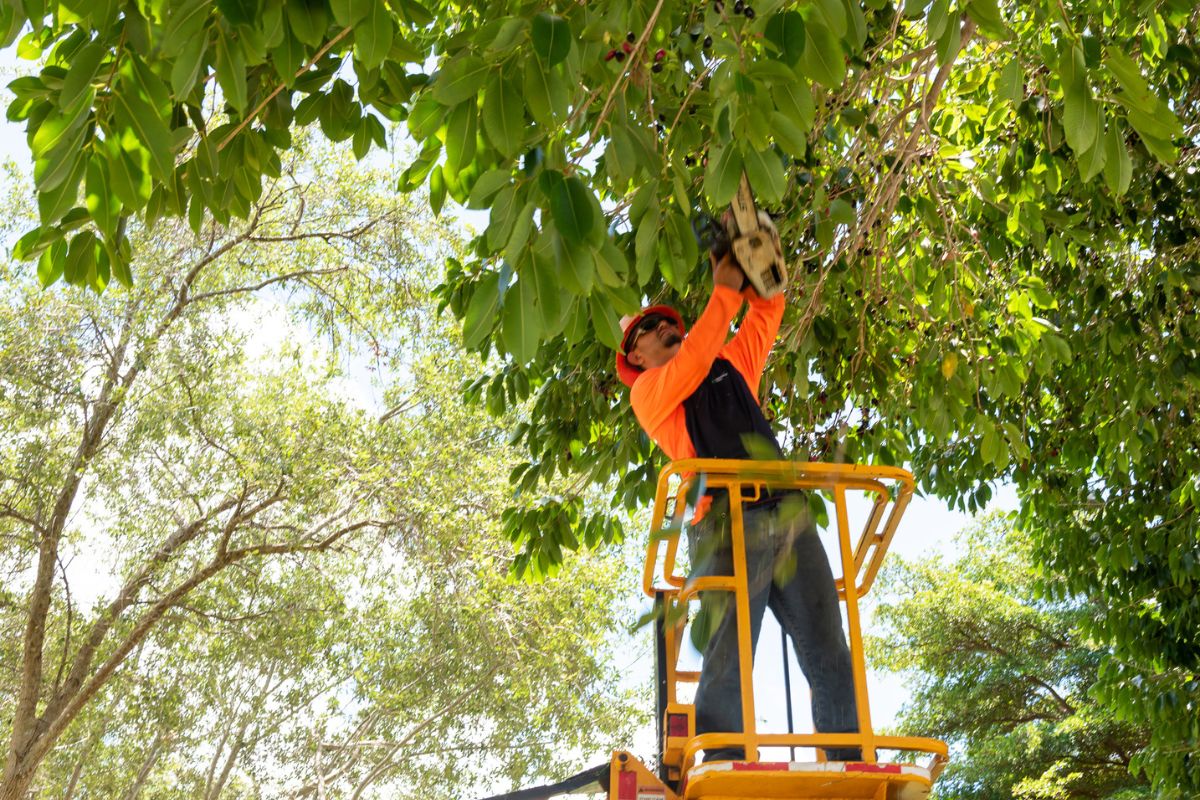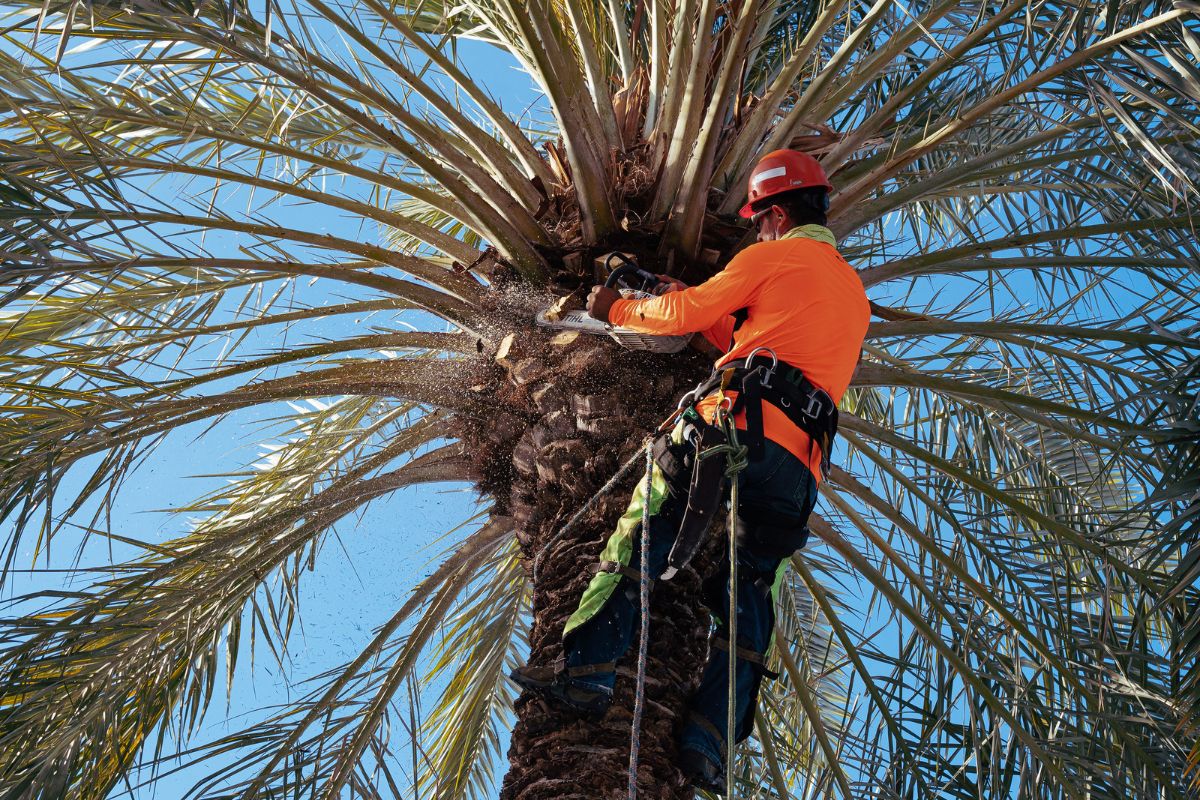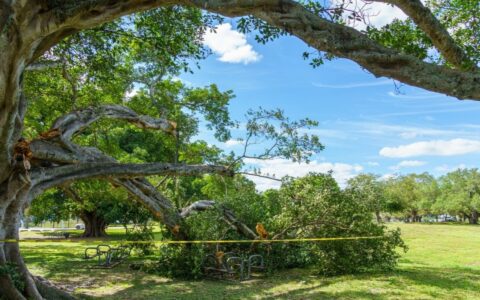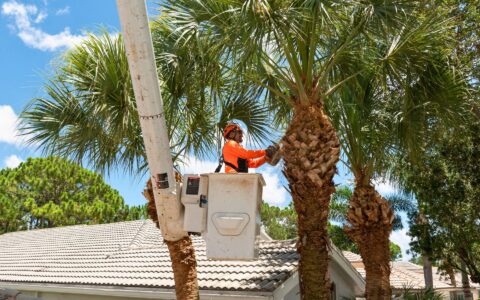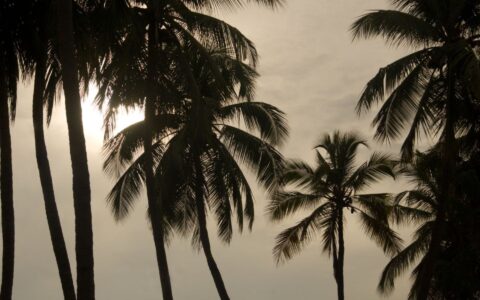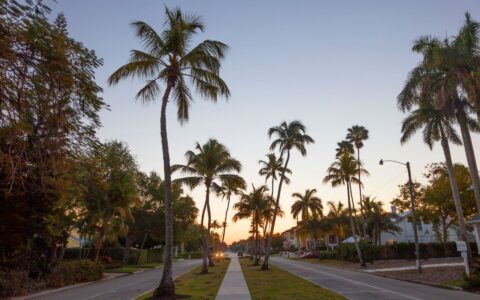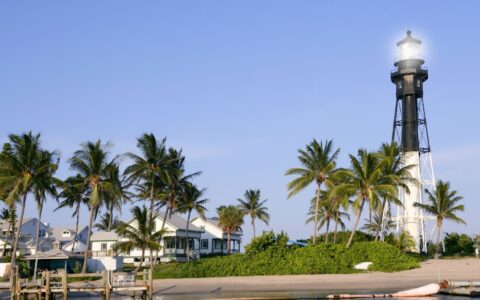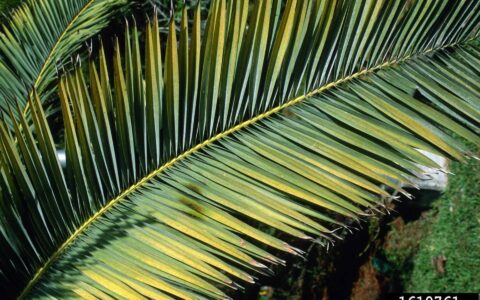If you’ve recently moved to South Florida, stepping into your backyard can feel like entering a jungle! With unfamiliar trees and shrubs, different weather patterns, strange insects and plant diseases, and soil that looks like sand, caring for your new South Florida trees and landscape can seem daunting at first.
At Sherlock Tree Company, we’re here to help you navigate these challenges. This brief guide, South Florida tree care for new residents, will equip you with the knowledge you need to care for your exotic trees and landscaping. From essential watering techniques, identifying diseases, and pruning best practices to selecting native species, we’ve got you covered.
- Regular soil testing is crucial for managing salinity and ensuring optimal plant growth.
- Understanding and preparing for the unique challenges of hurricane season is key to protecting your landscape.
- Choosing native plants supports local ecosystems and reduces ecological issues.
- Proper watering and pest management are essential due to the region’s warm and humid climate.
- Be aware of toxic and allergenic trees and seek professional help for safe handling.
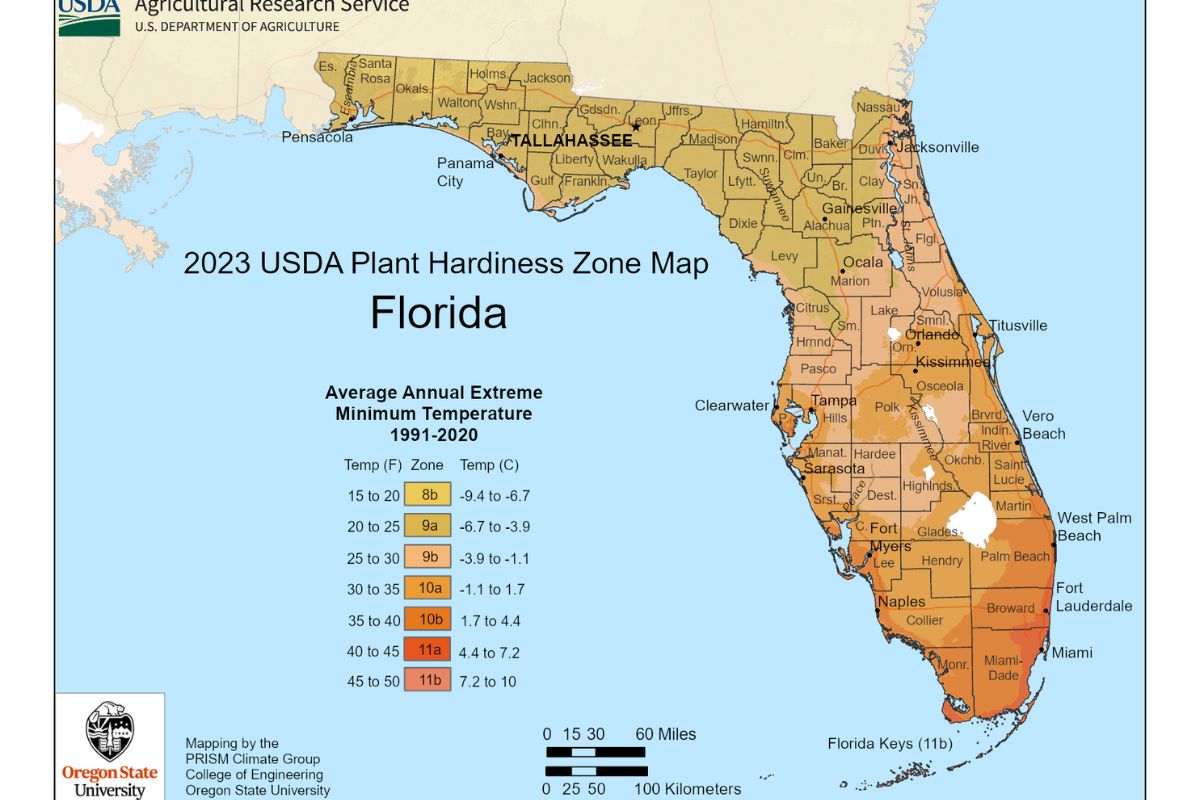
USDA Plant Hardiness Zone Map showing the different zones in South Florida. It’s important to understand which plants will and will not grow well in your zone.
Understanding Plant Hardiness Zones in South Florida
Most of South Florida is zone 10 or 11 in the USDA Hardiness Zone Map. These zones determine what trees and plants will flourish in your new environment. Trees, shrubs, and landscape plants that grow in more northern states may not survive the tropical and subtropical climate in our region. It’s important to understand which plants will and will not grow well in your zone and to select those that are most likely to thrive.
Seasons in South Florida: What to Expect
Many people think of South Florida as a tropical paradise, with white sand beaches, gently waving palms, and warm, humid, and sunny weather all year round. But the reality is far more complex, with cold winter weather, a rainy season, and brutally hot summers.
Winter
Although mild, winters in South Florida occasionally bring surprisingly cool temperatures that affect certain plant species. You’ll need to know how to protect your landscaping if temperatures occasionally drop into the 40s.
When it comes to the growing season, many annuals and crops that are grown during the spring or summer in the Northern United States are grown from the fall through spring in South Florida.
Understanding how much water and what kind of care your plants need in winter is crucial to keeping them healthy year-round.
Spring and Summer
Late spring through fall (mid-May through mid-October) coincides with South Florida’s rainy season. This means that you must be vigilant about managing pest infestations and fungal diseases, which can be more prevalent in warm, moist environments.
South Florida residents often take advantage of the warmer weather by growing various tropical plants that would not survive in cooler, less humid climates. However, with summer’s high temperatures, it’s important to keep close watch to ensure plants are getting enough water, particularly if the expected rains don’t materialize.
Fall
Mid-October through mid-May are typically drier months in our region. However, this can vary from year to year and tropical storms can cause rain and flooding during the “dry” season.
As temperatures moderate, fall is an ideal time for many gardening and landscape tasks, such as:
- planting trees and shrubs, allowing them to establish root systems before the heat of summer returns
- adding mulch to your garden beds, which helps retain soil moisture and regulate temperature during the cooler months
- fertilizing your lawns and gardens in early fall to support healthy growth and strengthen plants against potential cold snaps
- avoiding pruning (unless necessary to address damaged branches) to avoid stimulating new growth that could be susceptible to early winter chills
- preparing your landscapes for the dry season by adjusting irrigation systems
Preparing for Hurricane Season
Hurricane season in South Florida officially runs from June through November, although storms can hit outside of that timeframe. Hurricane preparation is key to minimize the impact on your trees and landscape.
Proper pruning is vital and should be done before hurricane season arrives (preferably during the winter months). This will help ensure that trees and shrubs are not overly dense and do not have weak, overextended branches that could become hazardous in strong winds.
We advise selecting and planting hurricane-resistant trees like live oaks or sabal palms. These trees have sturdy structures and deep root systems that make them more resilient to high winds.
When planting, consider the location carefully, avoiding areas too close to buildings or power lines to minimize potential damage during a storm.
After a hurricane, it’s not unusual to find your trees have been flooded. If so, follow these flooded tree recovery tips.
Understanding Soil Structure Challenges
In South Florida, gardeners and landscapers must actively manage the unique challenges of the local soil, especially its salinity. This salinity affects watering and fertilization routines and impacts plant stability.
To ensure plant health and growth, it’s essential to regularly test your soil. These tests reveal salinity levels and nutrient content, guiding the selection of appropriate irrigation methods and fertilizers.
Understanding and adapting to these soil conditions can foster a thriving garden environment in South Florida. Sherlock Tree’s full-service fertilization program includes semi-annual applications to keep plants green and growing all year, as well as spot treatments whenever needed.
Learn to Recognize Common Pests and Diseases
The warm and humid climate in South Florida creates a hospitable environment for various pests and diseases that can affect local vegetation.
One of the most common pests affecting trees in South Florida is the whitefly, a small insect that feeds on the underside of leaves, often causing yellowing, wilting, and stunted growth in plants.
Common diseases include fungal infections like powdery mildew and root rot, which thrive in humid conditions.
Managing these pests and diseases often requires a combination of cultural practices, such as proper watering and pruning and, when necessary, using pesticides or natural pest control methods. Understanding and identifying these challenges early on is crucial for maintaining healthy and thriving gardens in South Florida.
Sherlock’s Tree Health Management team offers services that can help you address infestations and proactively protect your landscaping from pests and disease.
Invasive Plants: What to Avoid
Relocating to South Florida from a different climate zone might inspire you to cultivate familiar plants and trees. However, some common species in northern regions could be considered harmful or invasive in South Florida. Introducing invasive plants and non-native tree species can lead to future ecological problems.
Instead, we recommend choosing native plants and trees that support local wildlife and enhance the local ecosystem.
Palm Tree Care
Palms, a symbol of South Florida’s landscape, aren’t actually trees at all and so require special care distinct from trees. Unlike trees, palms have a single growing point, and their roots do not thicken with age, making them sensitive to damage and improper pruning. Here’s what you need to know about caring for your palms:
- Essential palm care includes proper watering to ensure they receive enough moisture without becoming waterlogged.
- Palms have unique nutritional needs that differ from trees. They require a specialized fertilization regime that includes a blend of essential micronutrients to prevent deficiencies that can lead to health problems.
- Correct palm trimming practices do NOT include over-pruning (“carrot topping” or “hurricane cutting”). Doing this can weaken palms, making them more susceptible to pests and diseases and, ironically, more prone to hurricane damage.
- There are several lethal palm diseases and pests to look out for. Call a Certified Arborist if you suspect your palm may be infected as these diseases can easily spread to nearby palms.
Recognizing these unique care requirements is key to maintaining the health and beauty of your palms, making them a thriving part of South Florida’s lush landscape.
Identifying Toxic Trees
South Florida’s diverse landscape includes a variety of toxic or allergenic trees, presenting potential risks to you and your family or your pets. Among these are the poisonwood tree, known for its potent sap, and the highly dangerous manchineel tree. You should also be cautious around sago palms, whose seeds are particularly toxic.
New residents need to recognize that these hazardous trees exist in the region. For assistance with identifying, managing, or removing such trees, companies like Sherlock Tree provide expert services, ensuring safe and informed handling of these potentially dangerous plants.
Frequently Asked Questions
Q. How does sea salt spray affect South Florida trees?
A. Salt spray injury is particularly prevalent in trees near the ocean, but wind-borne salt can travel up to 1/2 a mile inland when blown by strong winds. Salt left on foliage will burn leaf tissue and leaf edges will turn brown and die. Eventually, the entire plant can die as it loses more and more leaves. The best way to avoid salt injury in your garden is to choose species that are resistant to salt damage.
Q. Is it really true that iguanas fall out of trees in the winter?
A. Yes, when temperatures fall into the 40s, cold-blooded iguanas slow down and become immobilized, lose their grip on branches, and often fall out of the tree. Thankfully, this paralysis effect is only temporary. They’re not “frozen” or dead and will wake up and walk away when they warm up.
Q. What are some common mistakes new residents make in caring for their trees in South Florida?
A. New residents often overwater their trees, not realizing South Florida’s high rainfall. They also might prune incorrectly, causing damage, or neglect local pest issues, leading to infestation and disease. Regular checkups are essential.
Q. Are there any local regulations or guidelines for tree care and landscaping in South Florida?
A. Yes, often, there are local regulations in South Florida for tree care and landscaping, particularly around irrigation. You’ll need to familiarize yourself with these rules, particularly your area’s water restrictions, to avoid penalties. They’re designed to protect the local environment and maintain aesthetics. Contact your local town or municipality for the most up-to-date information.
Q. I’m in a Homeowner’s Association (HOA). Who maintains the trees, prunes them, or removes them?
A. Generally, the tree’s owner is the one who owns the property on which the tree’s trunk is rooted. However, it gets much more complicated when the tree is on a property line or in a community space. Sherlock Tree works with many, many HOAs throughout South Florida. We would be happy to discuss your needs to see how we can best provide the services you need within your budget.
Flourishing in Florida with Sherlock Tree Company
Need expert advice or hands-on assistance with your new trees or landscape? Sherlock Tree Company, with our TCIA accreditation and team of ISA Certified Arborists, is just a call away. Let us guide you through the nuances of South Florida’s arboriculture, ensuring your outdoor space thrives in harmony with the local ecosystem. Reach out to us at 954-788-4000 and take the first step towards creating or maintaining your tropical haven!
Call Sherlock for quality tree services
Whether you're looking for specific tree care services, such as palm trimming, tree removal, or disease treatments, or would like one of our Arborists to examine your trees to identify any issues and recommend options, we're always here for you! Just give us a call at 954-788-4000 to set up an appointment.
SEE MORE ARTICLES
Looking for more?
We've got you covered with a monthly newsletter full of tips, resources, updates, how-to's, and other helpful information about trees and landscapes in South Florida!

